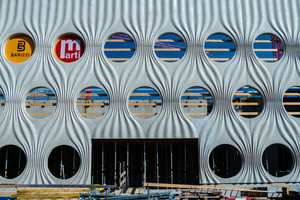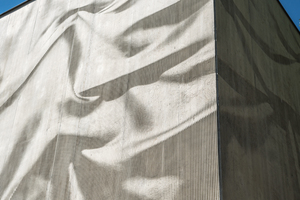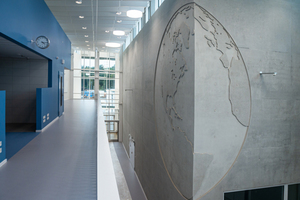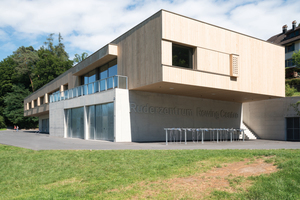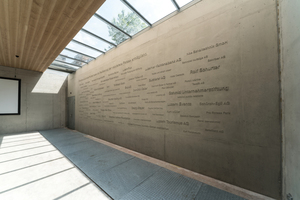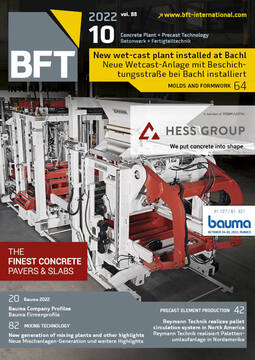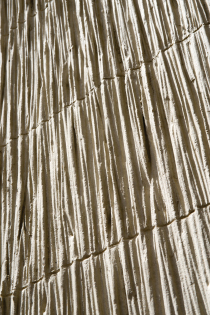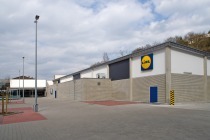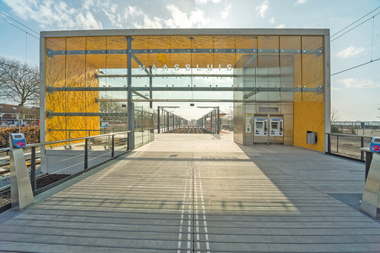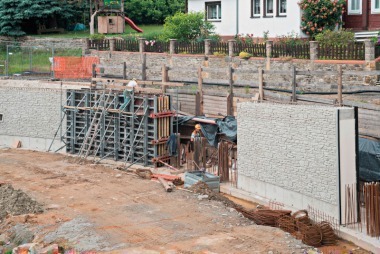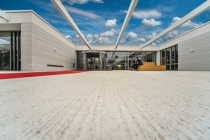Design of fair-faced concrete – quite individually
Good architecture is like a perfect suit – made-to-measure. That may be already reflected in the façade, for example, in the design of fair-faced concrete. Textured formliners are an excellent tool for achieving this. NOE-Schaltechnik also offers, in addition to a broad range of standard motifs, the possibility of realizing individual wishes for a customized design.
Outstanding architecture is often characterized by a building that is an absolute one-off. The architect has adapted the building to its location, its utilization and to a certain creative will. Some planners want to reflect this uniqueness beginning with the façade. For this, fair-faced concrete offers various possibilities. One of them, which has proved itself for many years now, is the textured surface. The most obvious way for achieving this is to place objects such as leaves, screws or the like into the formwork and to pour concrete over them. This, however, entails several risks: for example, that the materials react with the alkaline concrete, that the objects float upward, or that they simply do not have the desired form or size.
Textured formliners in general
A much more reliable alternative is formliners, which are commonly made of polyurethane and are fixed into the formwork. The whole procedure calls to mind baking a cake in a silicon tin – but with the difference that the concrete is not placed in an oven to harden. As soon as it has sufficiently hardened, it can be removed from the form, exposing the imprint of the formwork matrix on the surface of the concrete. All suppliers of such formliners have a certain assortment of standard reliefs that can texture the concrete surface. But some manufacturers – like NOE-Schaltechnik – go one step further. They provide their customers with the opportunity to realize their own individual design. In that way not only the building, but already the façade itself, become a one-off.
With CAD data
NOE-Schaltechnik has developed a polyurethane formula specifically for manufacture of formliners that the manufacturer offers under the name NOEplast. The formliners made of it have the same name. Today, many textured formliners are created with the aid of 3-D data – but there are still other possibilities which we will discuss later. Such data answer, for example, the following questions: on which parts of the building will the textured fair-face concrete be visible? What size are the concrete elements? What motif is desired? Should it be raised or sunk? And much more.
The staff of the company NOE will, based on this information, manufacture a basic form into which the special polyurethane will subsequently be poured. For this, a state-of-the-art CNC machine mills the desired design into wood, Ureol or PU. Which material is actually used depends on the given motif. In a special cabin, the staff at NOE will provide the form manufactured in this way with a coat of paint to smooth the surface further and to render it non-absorbent, if required.
Without CAD data
But formliners already existed before CAD software dominated the workaday world of architects and planners. At that time, textured formliners were made with real materials. In other words, objects such as genuine natural stone, rush mats or gypsum panels were placed into the formwork and subsequently cast with liquid NOEplast. Or, the planners brought into the plant their own models made of wood and/or clay, with which the formliners were manufactured. In contrast to the method described above – i.e., by placing the materials directly into the formwork and then pouring concrete over them – these formliners offer the great advantage that they can be reused up to 100 times. This is absolutely impossible with a natural material such as reed.
NOE, it goes without saying, still offers this method for manufacturing formliners. For many and various reasons, it is still frequently employed. Planners use it to offer a wide range of possibilities for realizing their individual ideas. Ornaments, lettering, dates on buildings, for example, and much more are effectively possible. There are only a few restrictions: undercuts in reliefs should be avoided, for instance, because concrete is very difficult, if at all, to remove from such forms.
NOE - a reliable partner on your side
The special characteristic of a building is already reflected in façade or fair-faced concrete walls designed with individual formliners. And for the company NOE, too, every construction project is unique. NOE supports its clients from planning to completion. Accordingly, NOE staff supports the client’s architect, engineers and building contractor not only in the design development phase. They, moreover, provide assistance in preparing the proposal and in helping to find solutions for solving tricky details – such as the design of edges and complete cycle plans that specify which formliner must be used when and in what order. In this way, absolutely individual architecture can be realized with savings in time and costs, and with the least strain on nerves.
Text: Claudia El-Ahwany
CONTACT
NOE-Schaltechnik
Georg Meyer-Keller GmbH + Co. KG
Kuntzestraße 72
73079 Süssen/Germany
+49 7162 13-1

